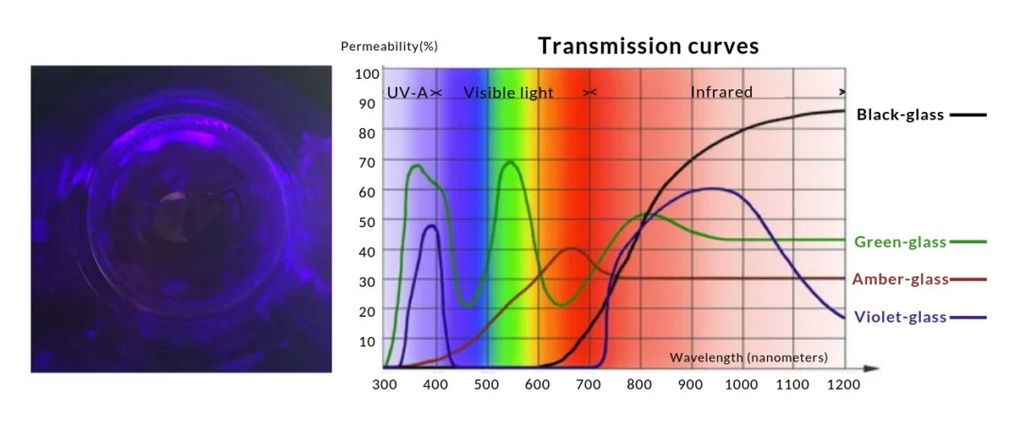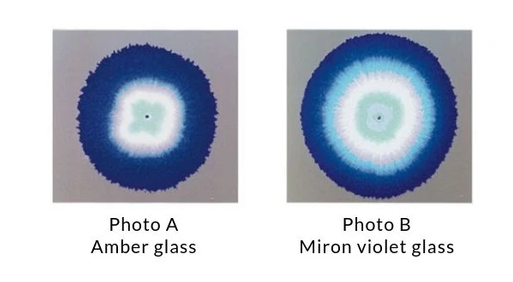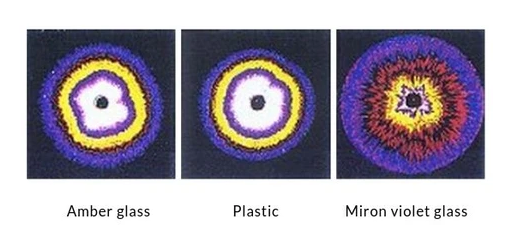Research and Technology to Prove the Effectiveness of NHT Violet Glass
May 25th 2022
NHT Violet Glass is produced by Miron Glass in Europe.
NHT does our research and so does Miron. Here is the science behind these amazing storage solutions.
Light Transmission Curve
The sun and its light are essential for our daily lives. Sunlight is enormously important for growth, but this same light also accelerates the process of molecular decay. As soon as plants, for example, are harvested, they are best used immediately or preserved efficiently. Any exposure to sunlight in this time can encourage the decomposition process, which may reduce the apparent quality and nutritional value of the plant. It is believed that this process is due to the visible spectrum of light.
Miron violet glass is designed to protect from this phenomenon by blocking visible light, while still allowing both long and short wavelength light to permeate. This page describes how this is done, and also how light can ‘activate’ organic material, and prevent healing energy from escaping.
The curve above describes the percentage of light able to permeate violet glass in the wavelength range of 300 – 1200 nm (from ultraviolet to infrared). Ultraviolet light can be divided into 3 ranges: UVC (200 – 290 nm), UVB (290 – 320 nm), and UVA (320 – 400nm), and Miron violet-glass has zero transmittance in the UVC and UVB range, meaning that no invisible UVB or UVC radiation can penetrate it. An amount of invisible UVA and visible violet light can pass through, but light in the visible range (450 nm – 720 nm) is completely blocked, which is what gives Miron glass its violet color. Wavelengths beyond the visible light in the near infrared range (720 nm – 1200 nm) are able to penetrate MIRON violet glass, peaking at 950 nm. Longer wavelength infrared (> 1200 nm), often associated with heat transfer, are also largely blocked.
As shown in the above curves, and demonstrated by the Institute Fraunhofer in Munich, Germany, light in the visible range (~450 nm – 720nm) does not penetrate violet glass nearly as readily as it does amber glass. This behavior, observed in all transparent glass, is referred to as a “quality leak”.
Light Research
An experiment conducted by the Institute of Dr. Dieter Knapp in
Mittenwald, Germany (October 1997) stored some homeopathic ingredients
for 36 days in both violet glass and amber glass. The results of this
test help to demonstrate the superiority of Miron violet glass in energy
preservation. The vibrant energies shown in photo B are what was
preserved in the violet glass sample. The results from photo A, however,
demonstrate the energy lost by storing the sample in amber glass.
The photos help show that storing substances in Miron Violet Glass, in particular: healing products such as homeopathic and flower remedies, tinctures, essences, energy-rich dietary supplements, essential oils, etc. has clear advantages in preserving energy, and importantly, efficacy.
Research by Prof. F.A. Popp and Dr. H. Niggli in 1997 – 1998 demonstrates that solar energy in our food is essential for our health. Solar energy in our cells can provide important information for the complex life processes taking place in our bodies, which can have a strong regulating and balancing effect on us. Dr. H. Niggli’s readings show that this solar energy is noticeably decreased by conventional packaging like amber glass, green glass, blue glass, aluminum foil, plastics, and other synthetic containers.
The photos below show the results of a test performed in 1997 by Dr. D. Knapp, in which Miron violet glass maintained and even enhanced the energy of a bottled spirulina sample over 4 weeks, unlike conventional packaging. The sample kept in violet glass exhibits a more dynamic energy field than those stored in amber glass or plastic, both of which observably lost energy in this time.
Biophotonics
Scientific research of biophotonics in the field of food quality control, led by Professor Fritz-Albert Popp, is performed at the International Institute for Biophysics (IIB) in Hombroich near Düsseldorf (Germany). In the early eighties he initiated this research at the University and at the Centre of Technology in Kaiserslautern (Germany). Since 1988, Dr. Niggli has collaborated scientifically with Professor Popp. In the middle of the nineties he started biophotonic research on the quality of food stored in a variety of package materials.
Biophotonics, the study of light particles absorbed and emitted by living cells, has shown that the wavelengths of light transmitted through Miron violet glass are very important for communication between living cells. Recent research in this field has also shown that the quality of nutrition not only depends on chemical composition, but also on the content of light energy and the potential information that is provided in UVA and IR light frequencies. This fundamental bio-information plays a crucial role in the control of all vital processes. Biophotonic measurements show that food, ripe grain, plants and fruits (freshly squeezed or dried) for example, as well as any extracts from plants, like olive and linseed oil, are perfect suppliers of light energy; a transfer which is closely connected to optical memorisation within a biological sample.
While it is understood that high-class edible goods lose their quality during storage and age prematurely, biophotonic research on the quality of food, contained in a variety of packaging materials, show that the quality of ordered bio-energy of food stored in violet-glass, is significantly higher than their counterparts kept in classical containers such as glass or plastic. This, it is argued, is a demonstration that optimal protection of bio-information is obtained during long-term storage in violet-glass.




